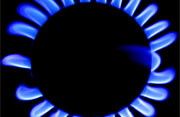As the European Union works toward meeting its obligations to reduce greenhouse gas emissions, switching from dirty, carbon-intensive coal to cleaner-burning natural gas has become a popular measure. At first glance, this makes perfect sense: Coal, particularly the kind still left in places like Germany, is highly polluting. Although widespread adoption of renewable energy is the ideal solution, wind, solar, and geothermal still have a ways to go before meeting European needs.
Natural gas has a CO2 content per unit of energy approximately 30 percent lower than oil and 50 percent lower than coal, making it a reasonable short-term solution. It is still relatively plentiful, with Norway at least 15 years from reaching peak production, and Russia already plugged into the European energy grid with high-capacity pipelines. Europe is counting on Russian production to fill the energy gap left by moving away from coal, but recent concerns about Russia's ability to satisfy demand have put this plan in doubt.
Russian consumers are using ever greater amounts of energy to power their newly acquired appliances and to heat their bigger homes. With Russian gas feeding expanded domestic electricity generation, less will be available for export to Europe. The Energy Information Administration sees Russian energy consumption growing at 2 percent, in parallel with the 7 percent or so at which the economy has been growing.
Early warnings of this trend have been sounded by the likes of Vladimir Milov, Russia's former deputy minister of energy and head of the Institute of Energy Policy in Moscow. In a recent International Energy Agency report, Daniel Simmons also expresses concern about the long-term viability of Russian gas supply, finding that Gazprom's "capital expenditures fall far short of what seems necessary to ensure sufficient new production."
European leaders are beginning to take notice. Yulia Tymoshenko, Ukraine's new prime minister, writes in Foreign Affairs of her own concern for Russia's inability to "increase gas supplies to Europe." Not surprisingly, Gazprom and the Russian government have embarked on a strategy of supplementing Russian gas production with additional inflows from Central Asia, and promoting gas conservation in the domestic market by accelerating the rise of gas prices to "market" levels. The two measures combined should indeed free up additional gas for export.
Satisfying European hunger for natural gas is not the only challenge facing the government-controlled energy establishment. Russians, and the Russian economy, have become accustomed to cheap energy. So much so, in fact, that without below-market gas prices many Russian industries would struggle against the giants of Europe and America. Russia may be known for its vast industrial output—it is not known for efficiency.
An end to cheap gas was a precondition for Russia's entry into the WTO, as was an arrangement between Brussels and Moscow for Russia to ratify the Kyoto Protocol. The two goals may be impossible to reconcile. A study by Hermitage Capital Management found that some Russian industries, such as metals processing and chemicals, enjoy higher margins than their Western competitors thanks to the below-market price they pay for gas. Should that cheap gas become a thing of the past, the study goes on to say, other sources of energy would have to be found.
For Russia, this is where coal comes in. Shunned by the EU due to its high carbon content and acid rain–causing sulfur, coal is nevertheless the most abundant fossil fuel on earth. Russia holds among the world's largest reserves of this resource, untapped and accessible. To date, it was simply easier to use gas—it flows by pipeline, is cleaner, and had been easy to extract until recently. Russia may be the only country in the world where coal costs more than gas per thermal unit of energy.
Now that the cost of developing new gas fields is rising, and the geography and geology is becoming more difficult, coal is making a comeback in Russia. It is no coincidence that just as gas prices are on the rise, the government is on the verge of introducing a more favorable tax regime for coal extraction.
The implications of this policy shift are clear. Gas is Russia's number one earning export. The more it exports, the more government coffers swell. In order to maximize revenues, alternatives to gas must be found for the domestic market, lest the lights go out. Looking forward to 2020, the Kremlin's strategic plan calls for the construction of four new nuclear power plants, 30 biofuel plants, and lots and lots of coal. Gazprom, the Russian monopoly gas exporter and owner of vast electricity generation assets, is already positioning itself to make the fuel switch, having recently merged its power-producing unit with Siberian Coal Energy Company, Russia's largest coal producer.
The implications for Europe are serious. The EU has painted itself into a corner, according to a foreign diplomat based in Moscow. The region strives to be a model for other countries with its climate mitigation efforts, forcing it to move into natural gas and renewables. The diplomat went on to say that although the European population is supportive of more drastic energy consumption reduction measures, and companies in wind and solar have access to excellent financing, the lack of an EU-wide comprehensive energy policy creates gaps in the market that Gazprom is all too ready to exploit. Gas will be the low-carbon energy option of choice in Europe for a while yet.
In the near future, methane will not be the only gas coming out of Russia—the lucrative export will be combined with rising CO2 emissions. Europe will thus reduce its own carbon footprint by exporting its coal-generating capacity and greenhouse gases to Russia.
![]() This article is licensed under a Creative Commons License.
This article is licensed under a Creative Commons License.
Please read our usage policy.




